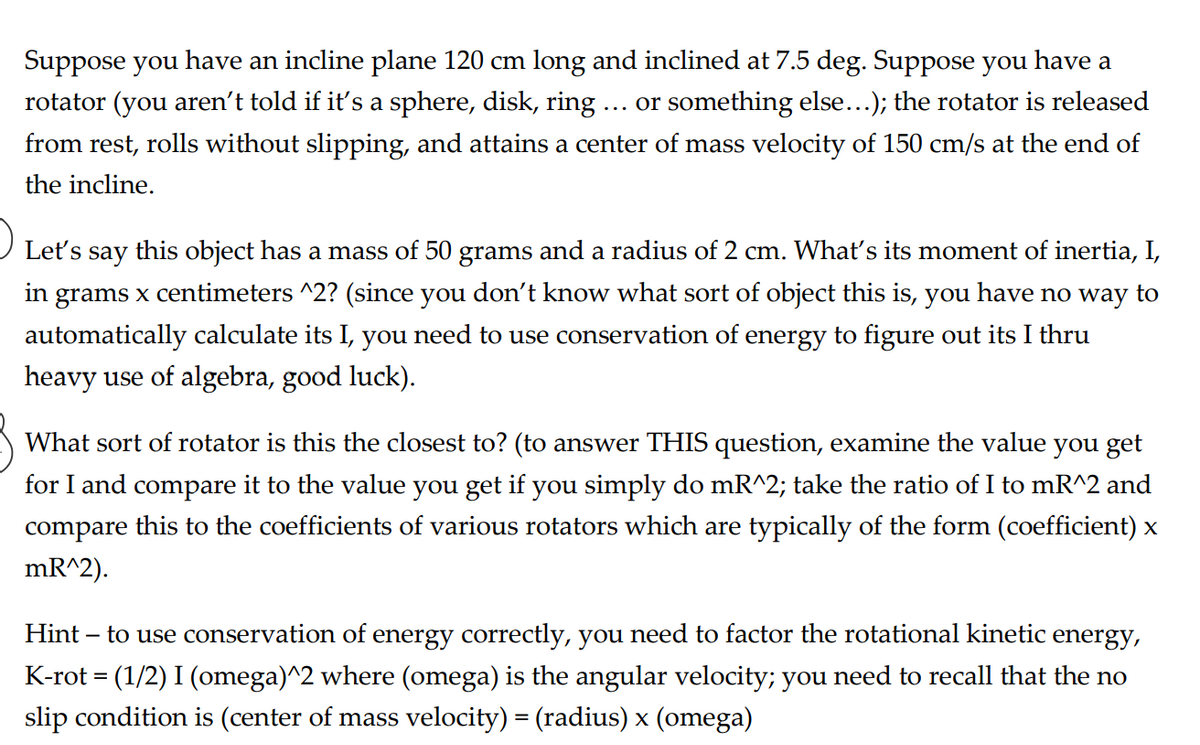Suppose you have an incline plane 120 cm long and inclined at 7.5 deg. Suppose you have a rotator (you aren't told if it's a sphere, disk, ring ... or something else...); the rotator is released from rest, rolls without slipping, and attains a center of mass velocity of 150 cm/s at the end of the incline. Leť's say this object has a mass of 50 grams and a radius of 2 cm. Whať's its moment of inertia, I, in grams x centimeters ^2? (since you don't know what sort of object this is, you have no way to automatically calculate its I, you need to use conservation of energy to figure out its I thru heavy use of algebra, good luck). What sort of rotator is this the closest to? (to answer THIS question, examine the value you get for I and compare it to the value you get if you simply do mR^2; take the ratio of I to mR^2 and compare this to the coefficients of various rotators which are typically of the form (coefficient) x mR^2). Hint – to use conservation of energy correctly, you need to factor the rotational kinetic energy, K-rot = (1/2) I (omega)^2 where (omega) is the angular velocity; you need to recall that the no slip condition is (center of mass velocity) = (radius) x (omega)
Suppose you have an incline plane 120 cm long and inclined at 7.5 deg. Suppose you have a rotator (you aren't told if it's a sphere, disk, ring ... or something else...); the rotator is released from rest, rolls without slipping, and attains a center of mass velocity of 150 cm/s at the end of the incline. Leť's say this object has a mass of 50 grams and a radius of 2 cm. Whať's its moment of inertia, I, in grams x centimeters ^2? (since you don't know what sort of object this is, you have no way to automatically calculate its I, you need to use conservation of energy to figure out its I thru heavy use of algebra, good luck). What sort of rotator is this the closest to? (to answer THIS question, examine the value you get for I and compare it to the value you get if you simply do mR^2; take the ratio of I to mR^2 and compare this to the coefficients of various rotators which are typically of the form (coefficient) x mR^2). Hint – to use conservation of energy correctly, you need to factor the rotational kinetic energy, K-rot = (1/2) I (omega)^2 where (omega) is the angular velocity; you need to recall that the no slip condition is (center of mass velocity) = (radius) x (omega)
Elements Of Electromagnetics
7th Edition
ISBN:9780190698614
Author:Sadiku, Matthew N. O.
Publisher:Sadiku, Matthew N. O.
ChapterMA: Math Assessment
Section: Chapter Questions
Problem 1.1MA
Related questions
Question
Please answer this and do not skip any steps. Double check your work. Please do not skip any steps!

Transcribed Image Text:Suppose you have an incline plane 120 cm long and inclined at 7.5 deg. Suppose you have a
rotator (you aren't told if it's a sphere, disk, ring
or something else...); the rotator is released
...
from rest, rolls without slipping, and attains a center of mass velocity of 150 cm/s at the end of
the incline.
Leť's
say this object has a mass of 50 grams and a radius of 2 cm. Whať's its moment of inertia, I,
in grams x centimeters ^2? (since you don't know what sort of object this is, you have no way to
automatically calculate its I, you need to use conservation of energy to figure out its I thru
heavy use of algebra, good luck).
What sort of rotator is this the closest to? (to answer THIS question, examine the value you get
for I and compare it to the value you get if you simply do mR^2; take the ratio of I to mR^2 and
compare this to the coefficients of various rotators which are typically of the form (coefficient) x
mR^2).
Hint – to use conservation of energy correctly, you need to factor the rotational kinetic energy,
K-rot = (1/2) I (omega)^2 where (omega) is the angular velocity; you need to recall that the no
slip condition is (center of mass velocity) = (radius) x (omega)
Expert Solution
This question has been solved!
Explore an expertly crafted, step-by-step solution for a thorough understanding of key concepts.
This is a popular solution!
Trending now
This is a popular solution!
Step by step
Solved in 3 steps

Knowledge Booster
Learn more about
Need a deep-dive on the concept behind this application? Look no further. Learn more about this topic, mechanical-engineering and related others by exploring similar questions and additional content below.Recommended textbooks for you

Elements Of Electromagnetics
Mechanical Engineering
ISBN:
9780190698614
Author:
Sadiku, Matthew N. O.
Publisher:
Oxford University Press

Mechanics of Materials (10th Edition)
Mechanical Engineering
ISBN:
9780134319650
Author:
Russell C. Hibbeler
Publisher:
PEARSON

Thermodynamics: An Engineering Approach
Mechanical Engineering
ISBN:
9781259822674
Author:
Yunus A. Cengel Dr., Michael A. Boles
Publisher:
McGraw-Hill Education

Elements Of Electromagnetics
Mechanical Engineering
ISBN:
9780190698614
Author:
Sadiku, Matthew N. O.
Publisher:
Oxford University Press

Mechanics of Materials (10th Edition)
Mechanical Engineering
ISBN:
9780134319650
Author:
Russell C. Hibbeler
Publisher:
PEARSON

Thermodynamics: An Engineering Approach
Mechanical Engineering
ISBN:
9781259822674
Author:
Yunus A. Cengel Dr., Michael A. Boles
Publisher:
McGraw-Hill Education

Control Systems Engineering
Mechanical Engineering
ISBN:
9781118170519
Author:
Norman S. Nise
Publisher:
WILEY

Mechanics of Materials (MindTap Course List)
Mechanical Engineering
ISBN:
9781337093347
Author:
Barry J. Goodno, James M. Gere
Publisher:
Cengage Learning

Engineering Mechanics: Statics
Mechanical Engineering
ISBN:
9781118807330
Author:
James L. Meriam, L. G. Kraige, J. N. Bolton
Publisher:
WILEY